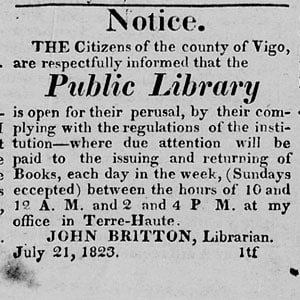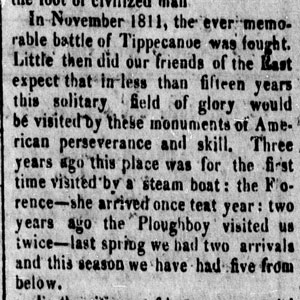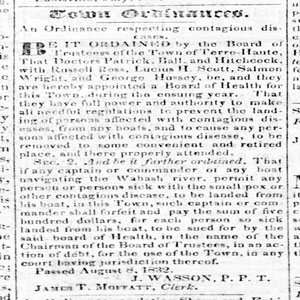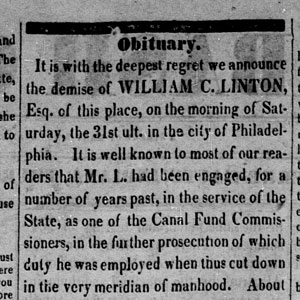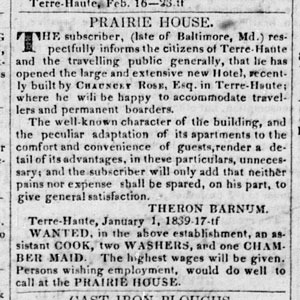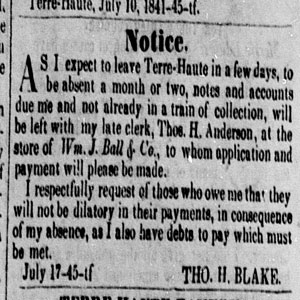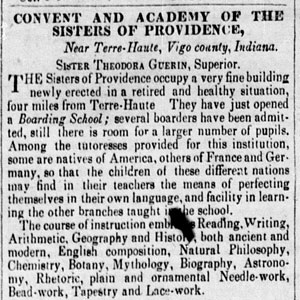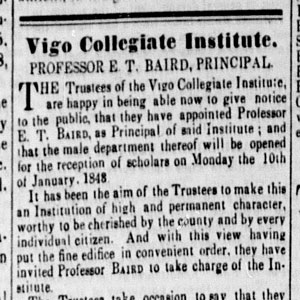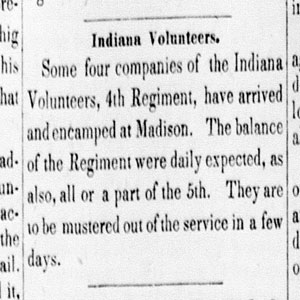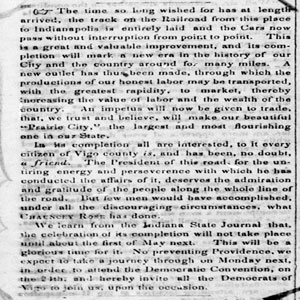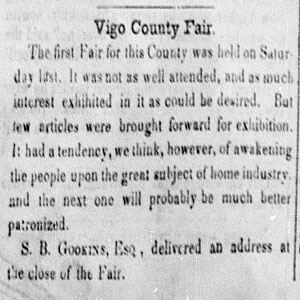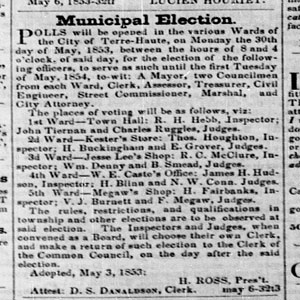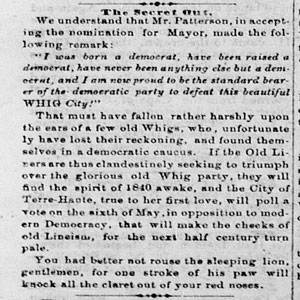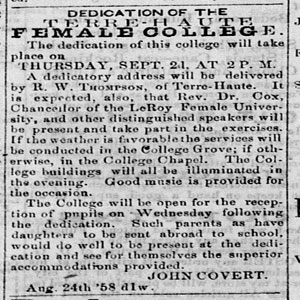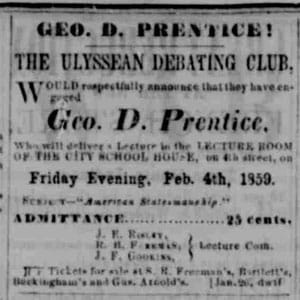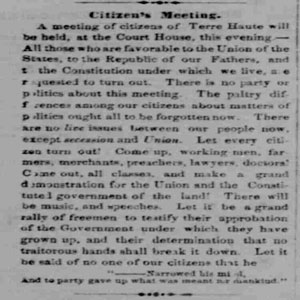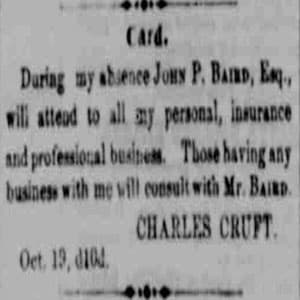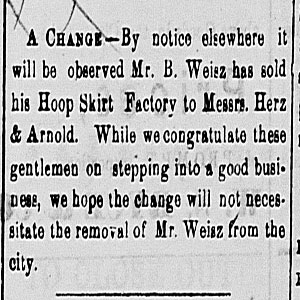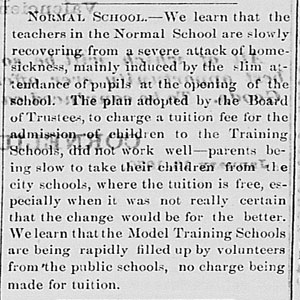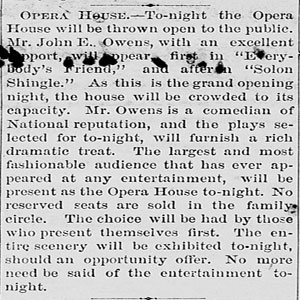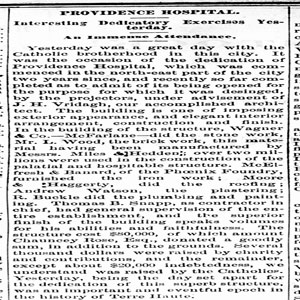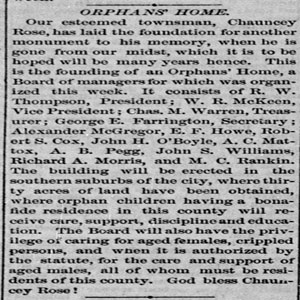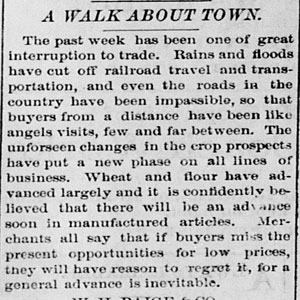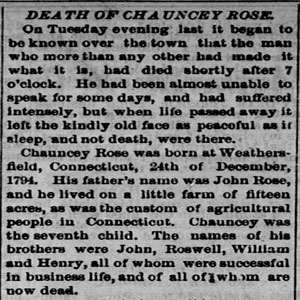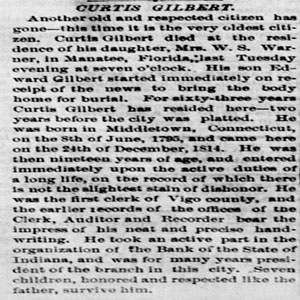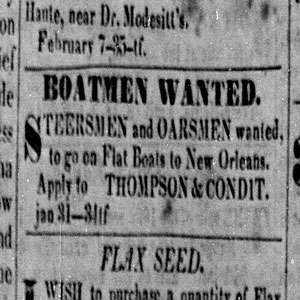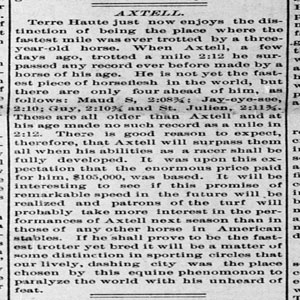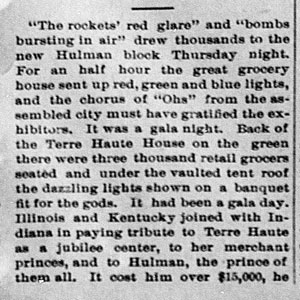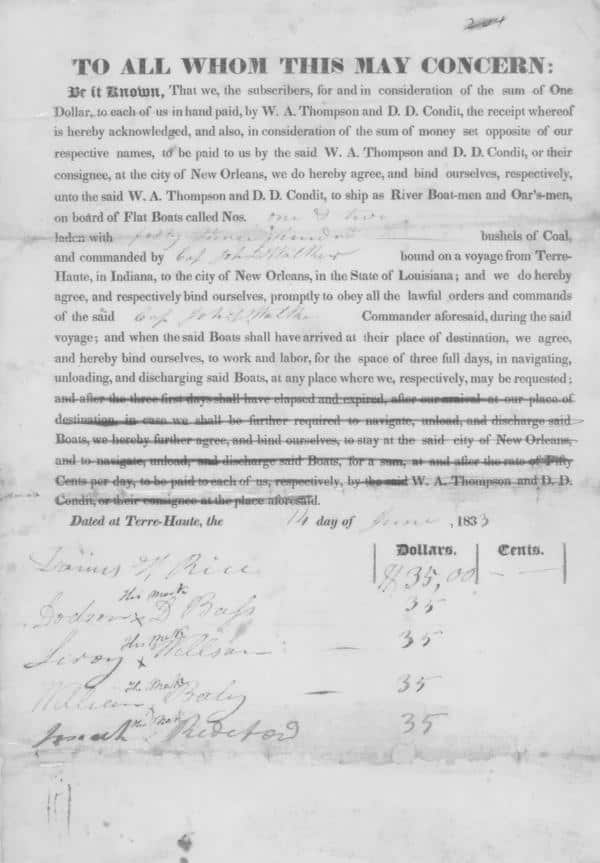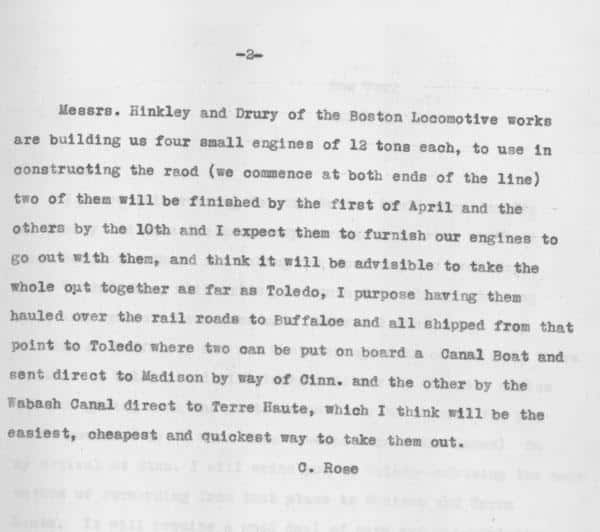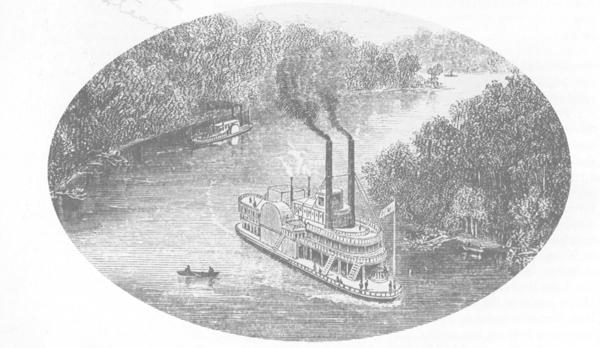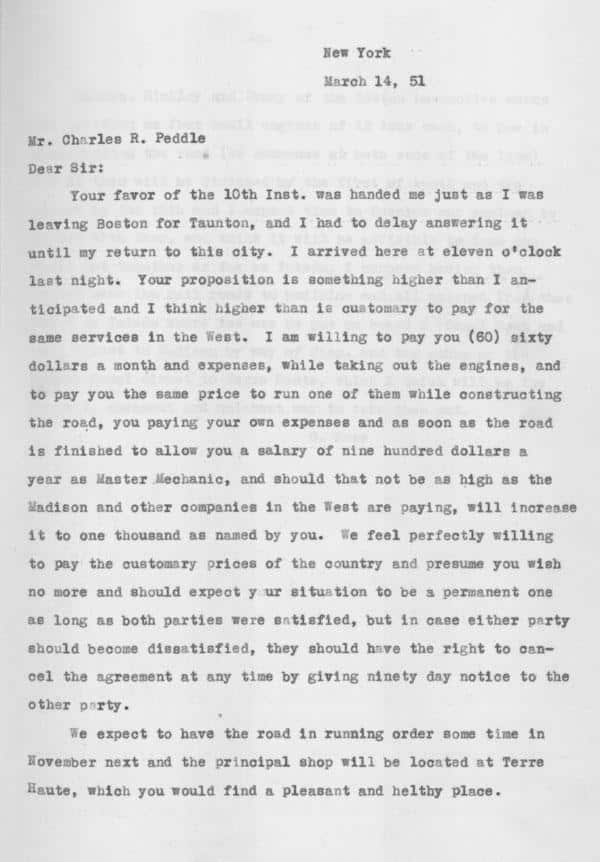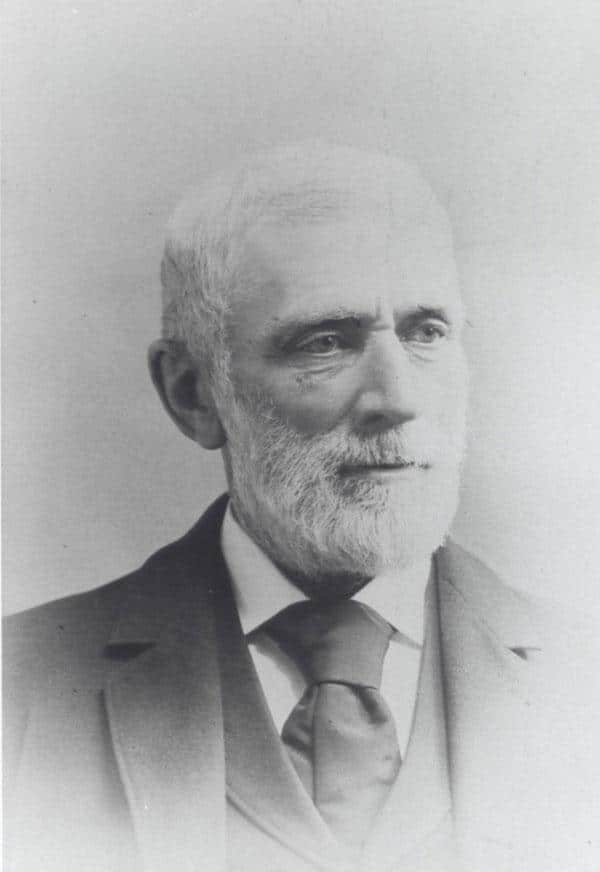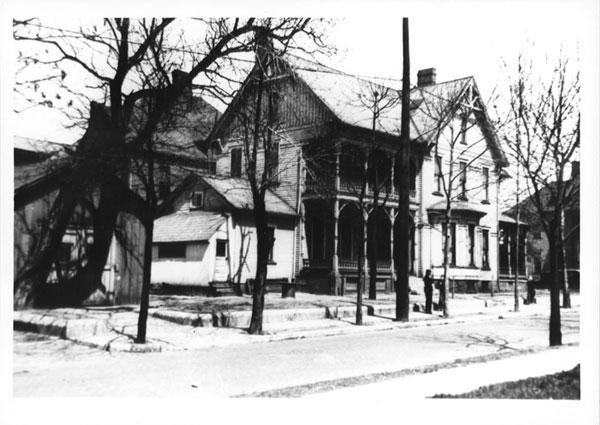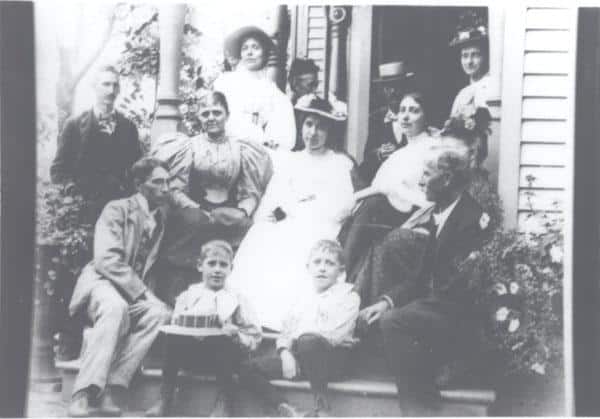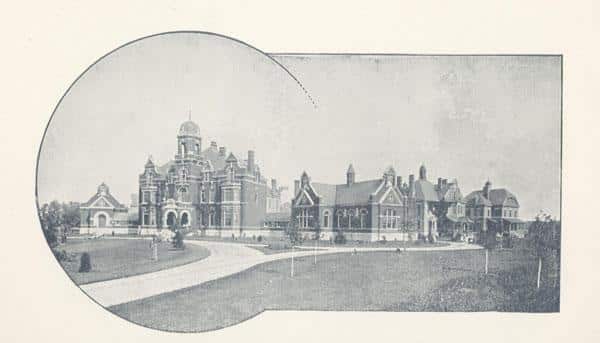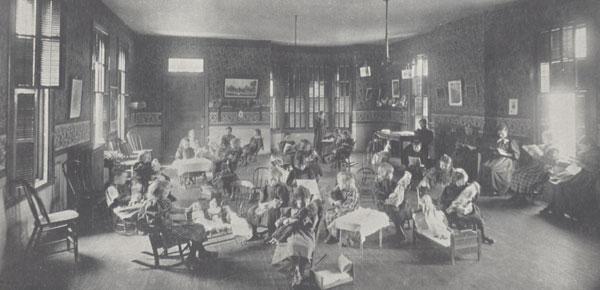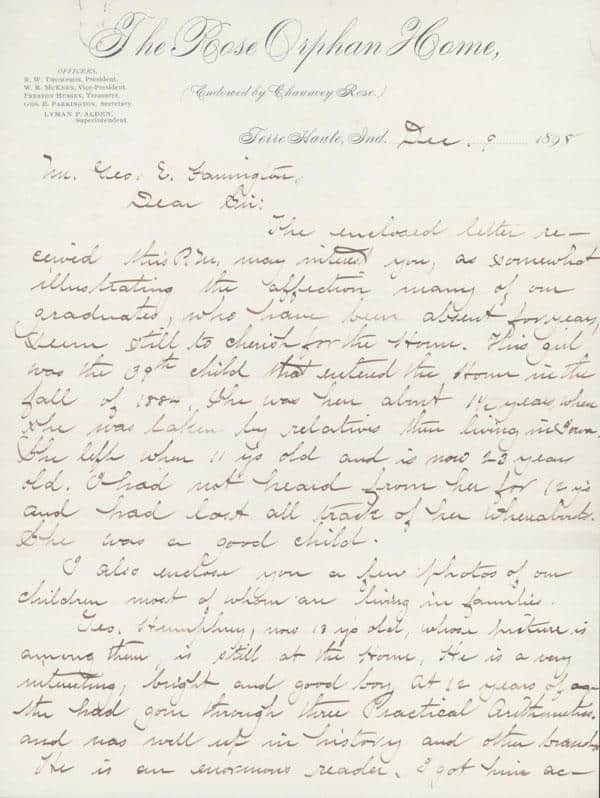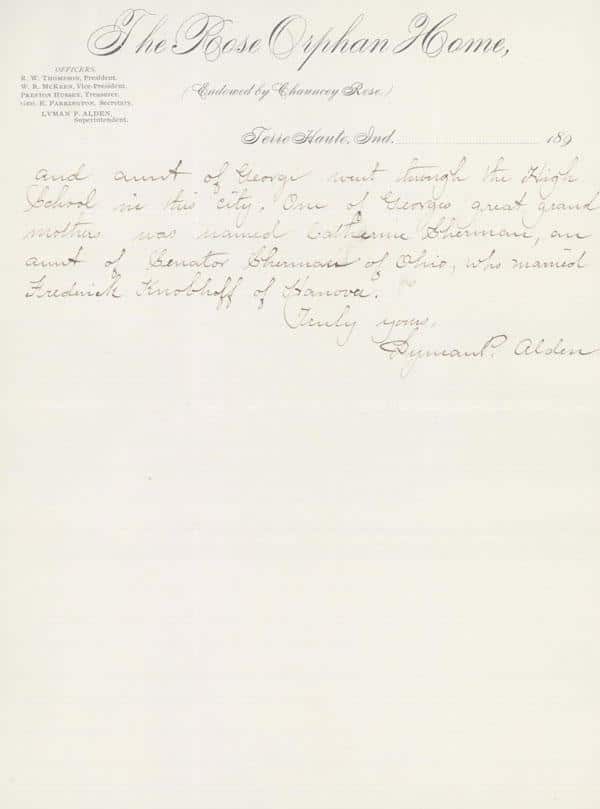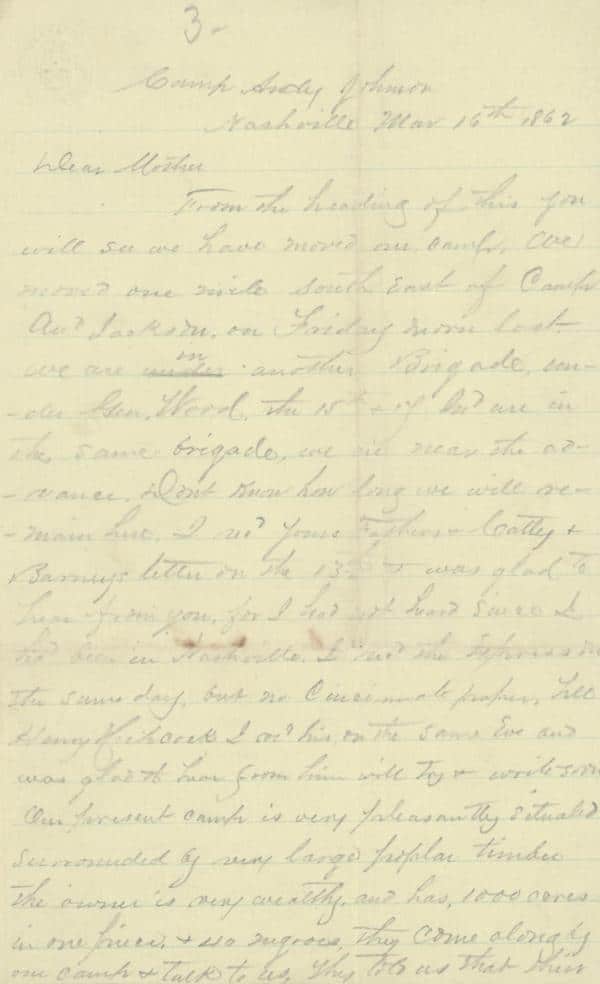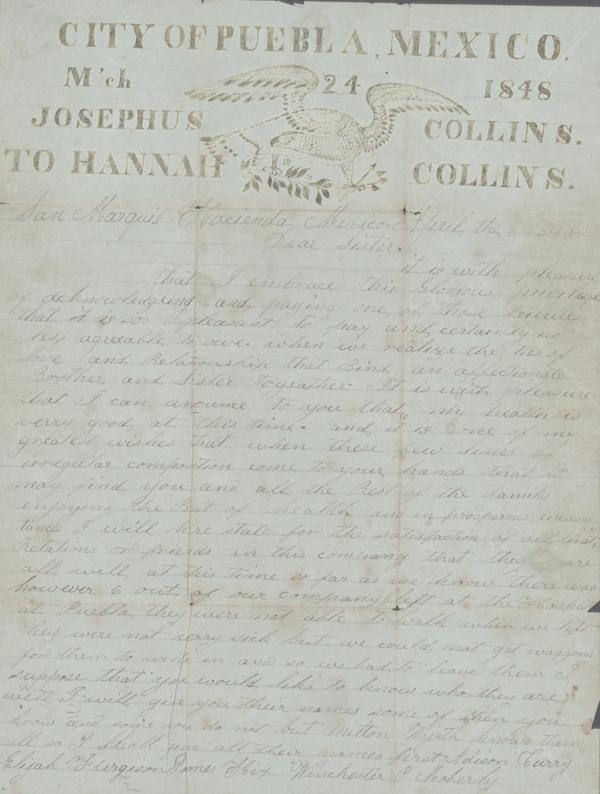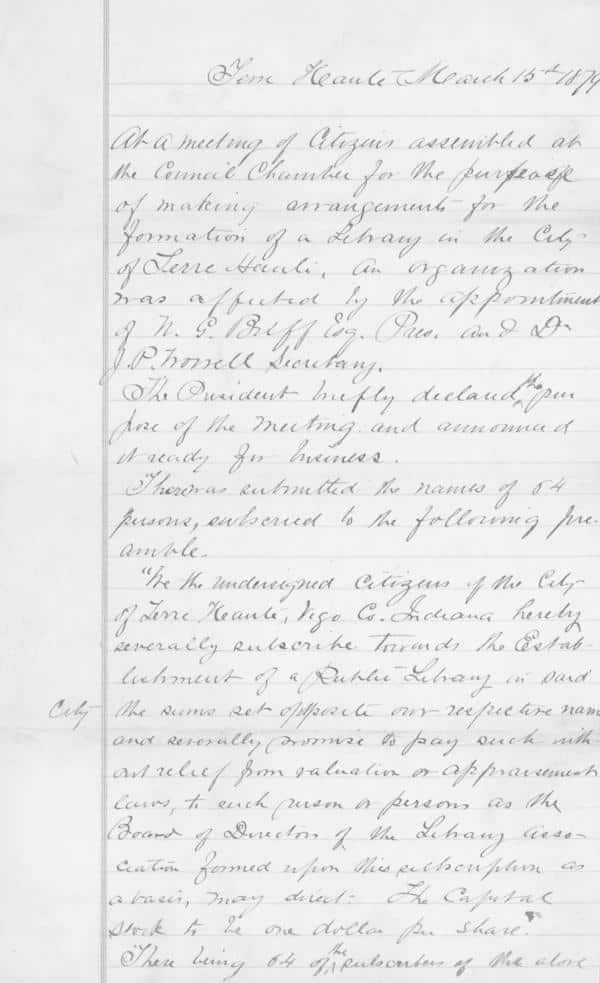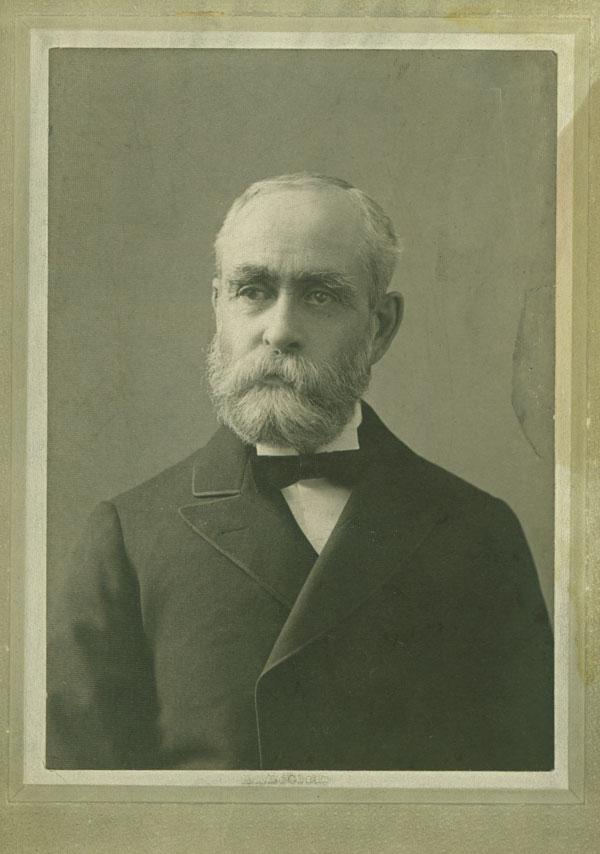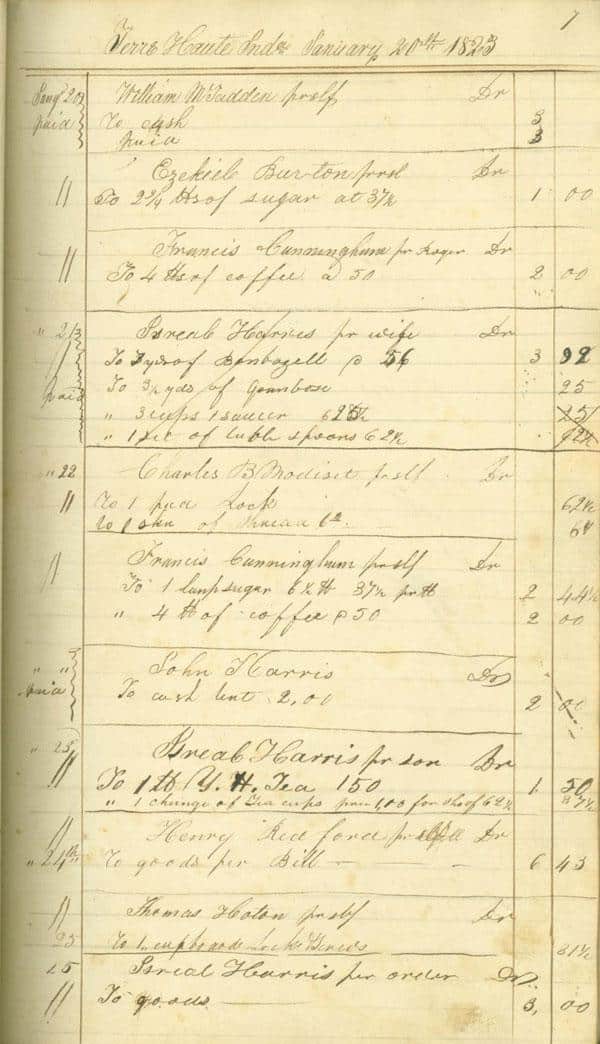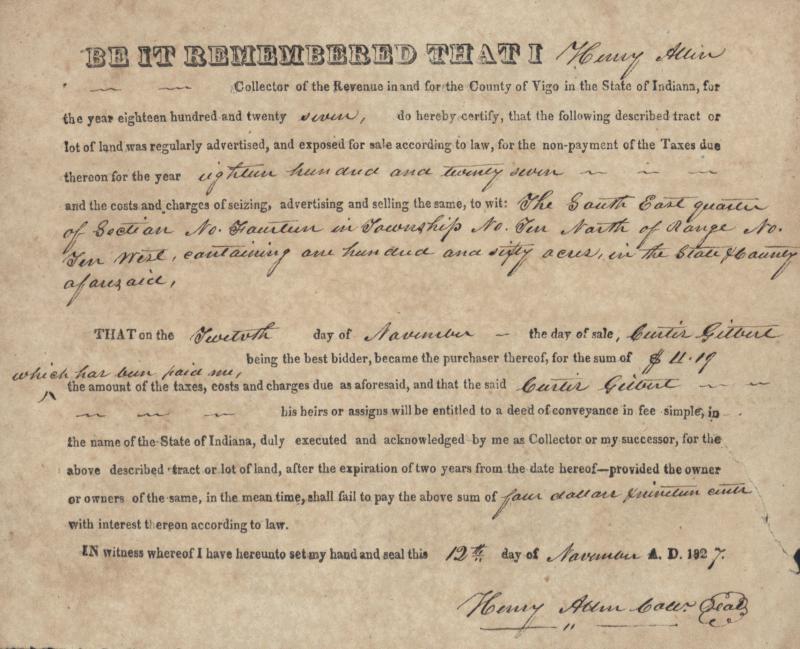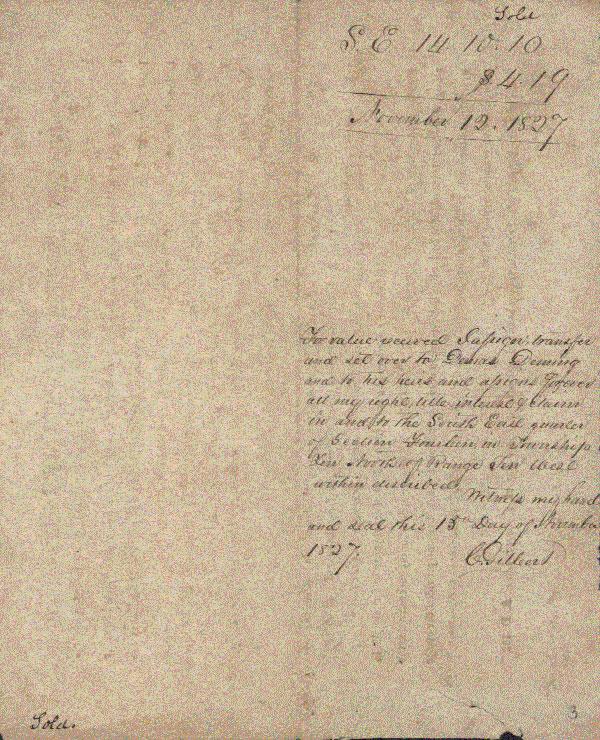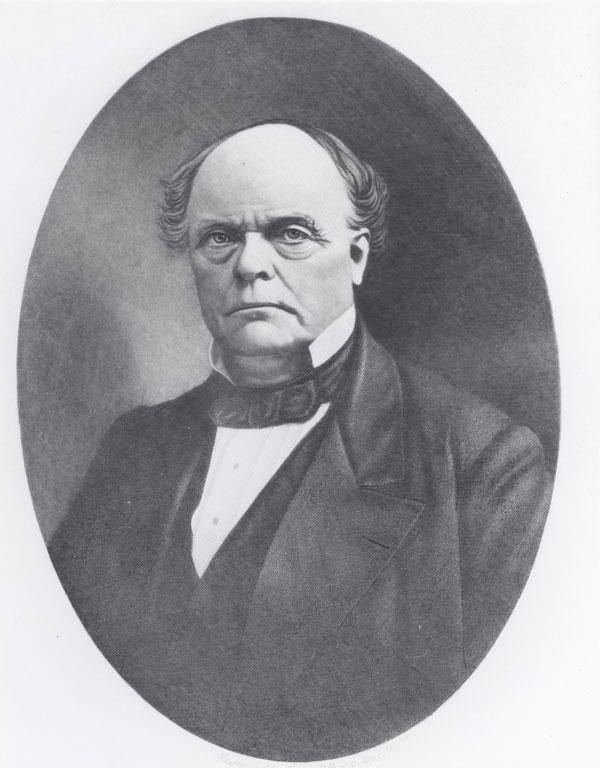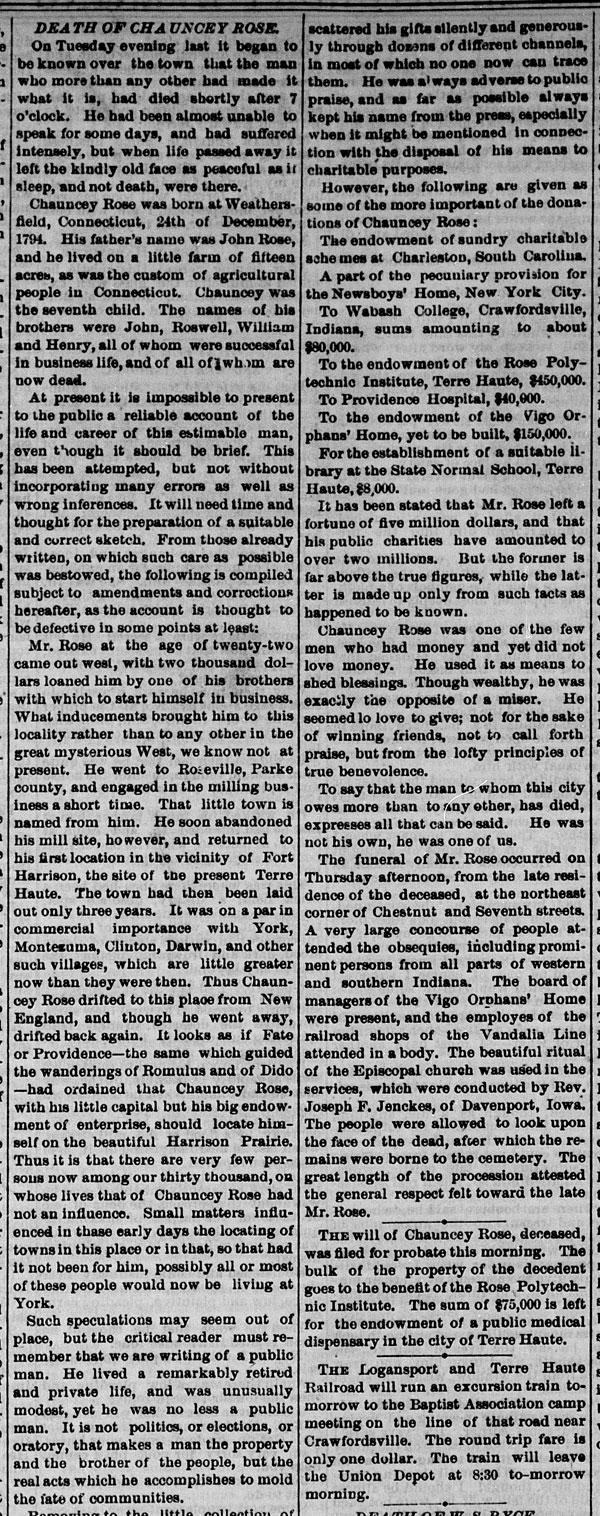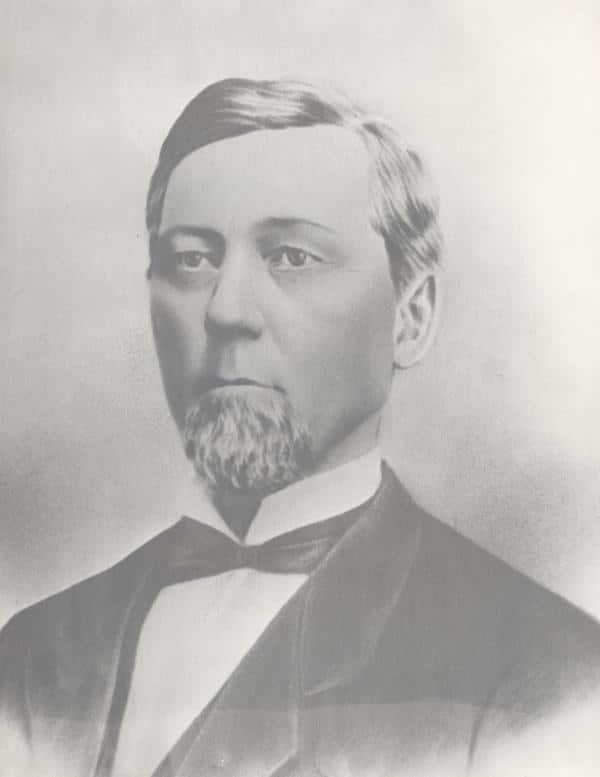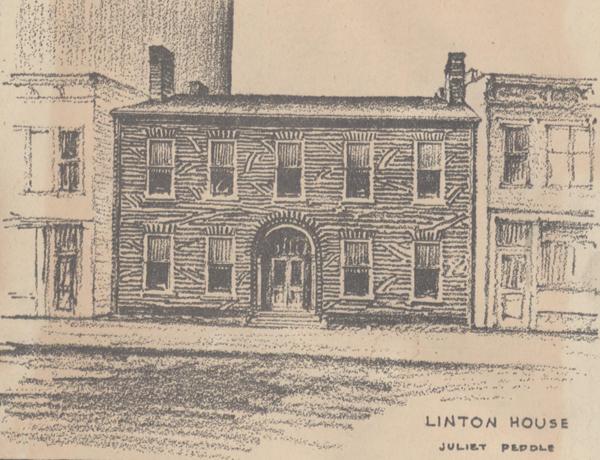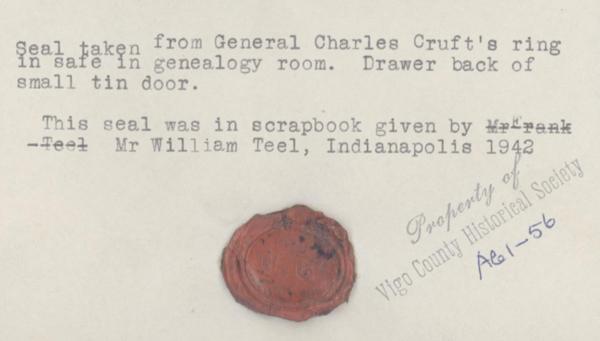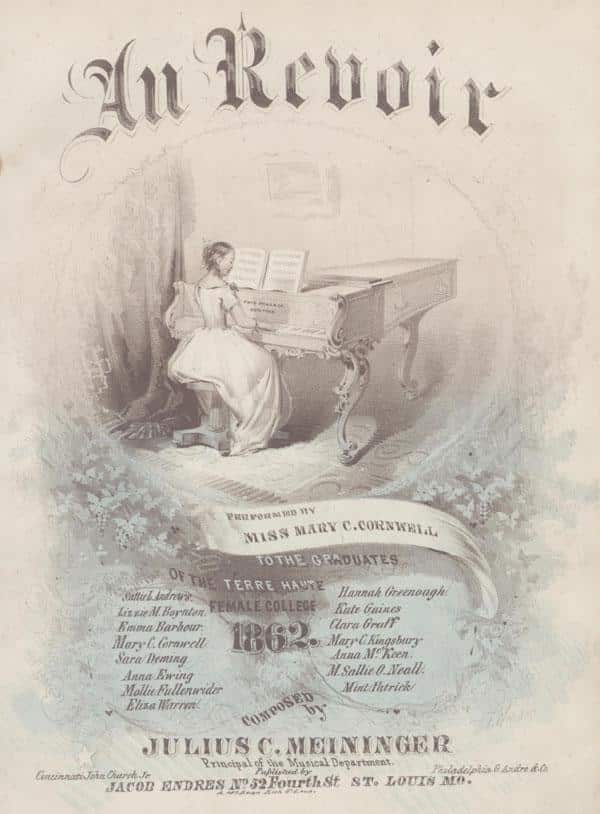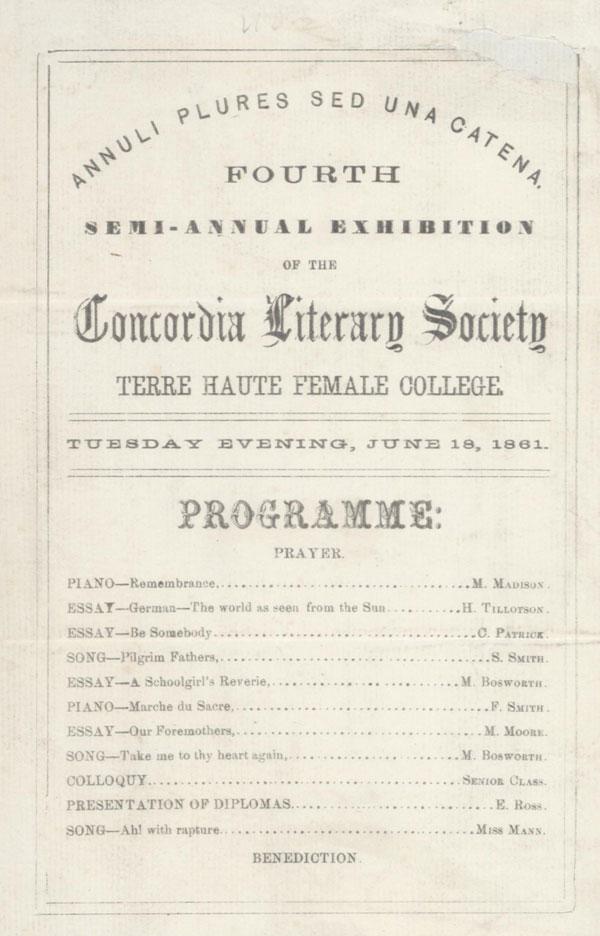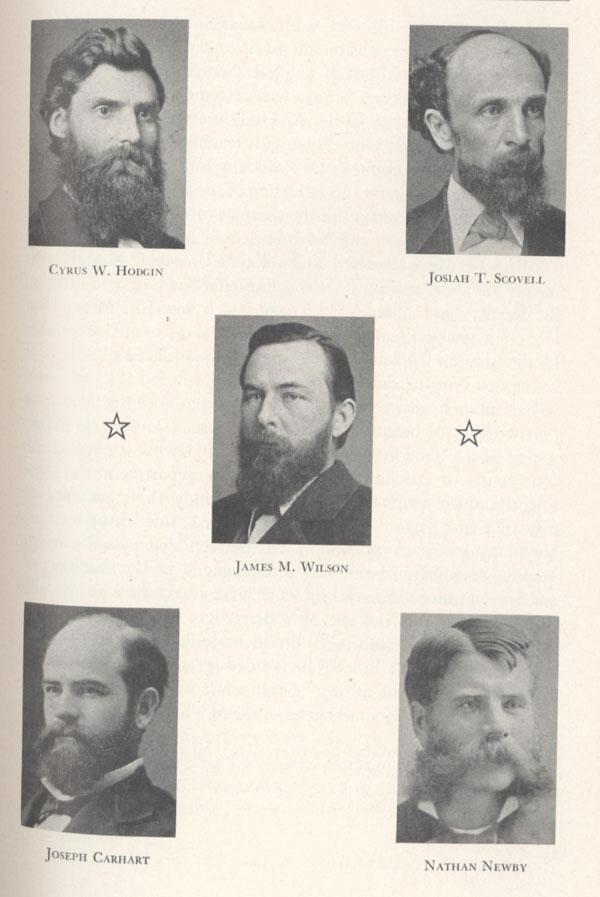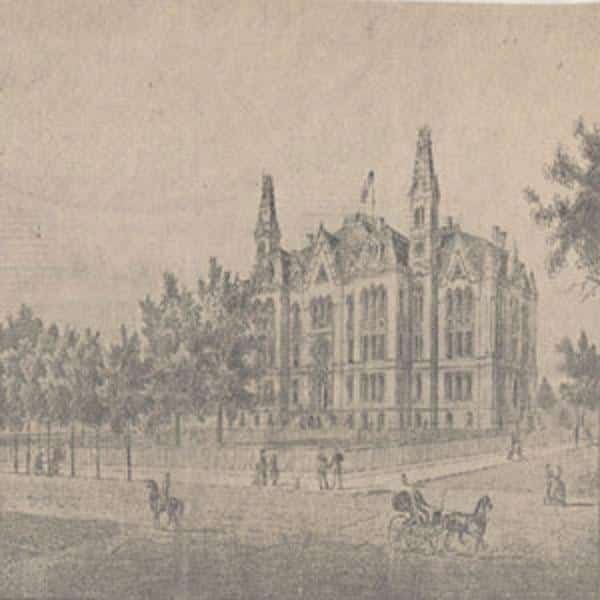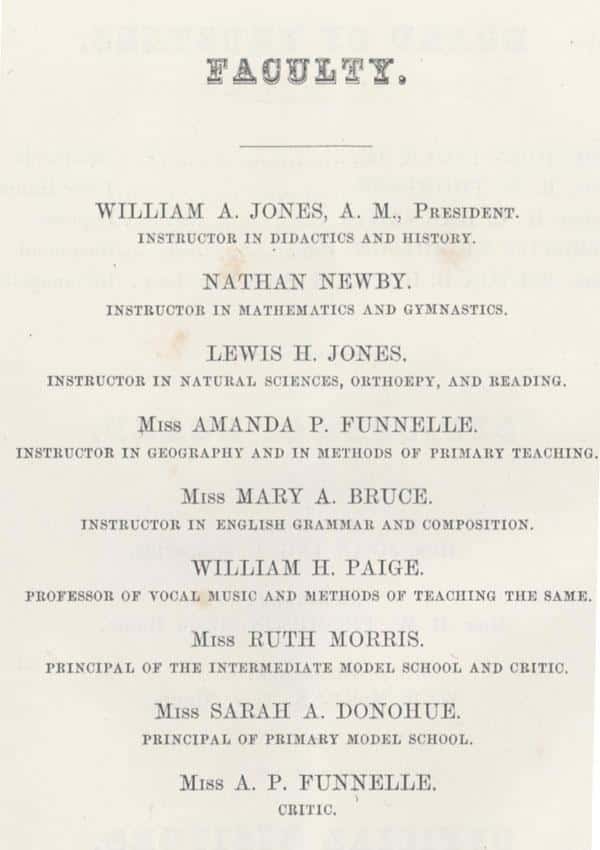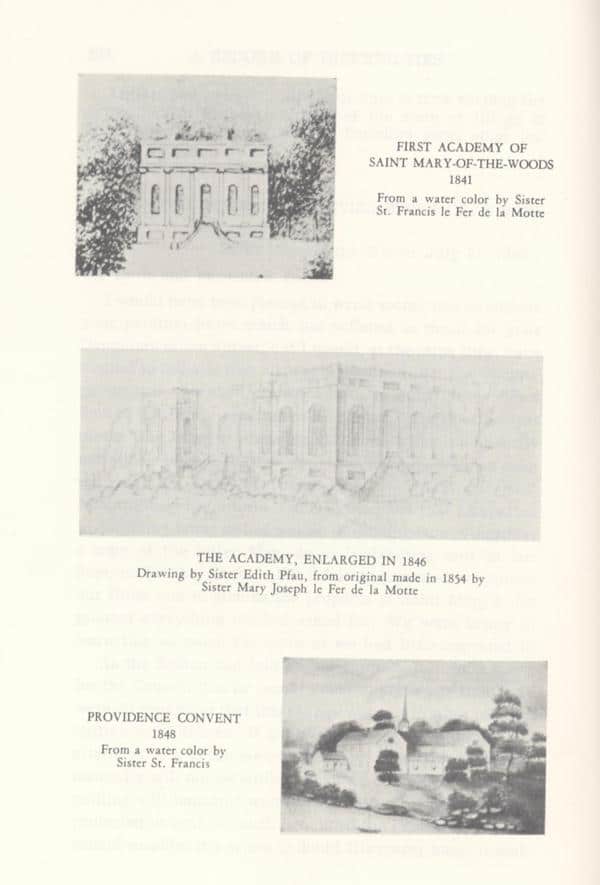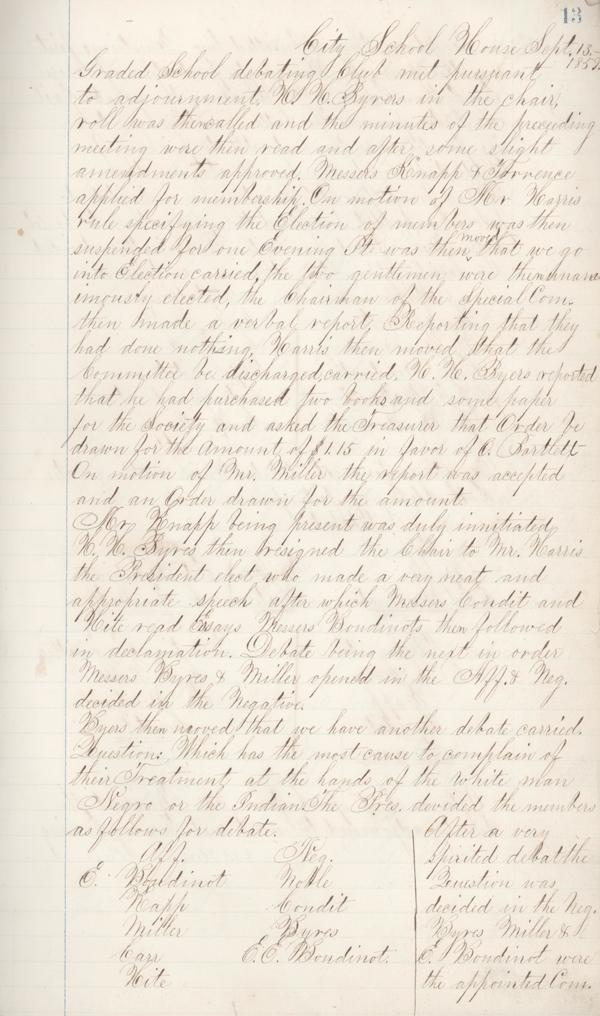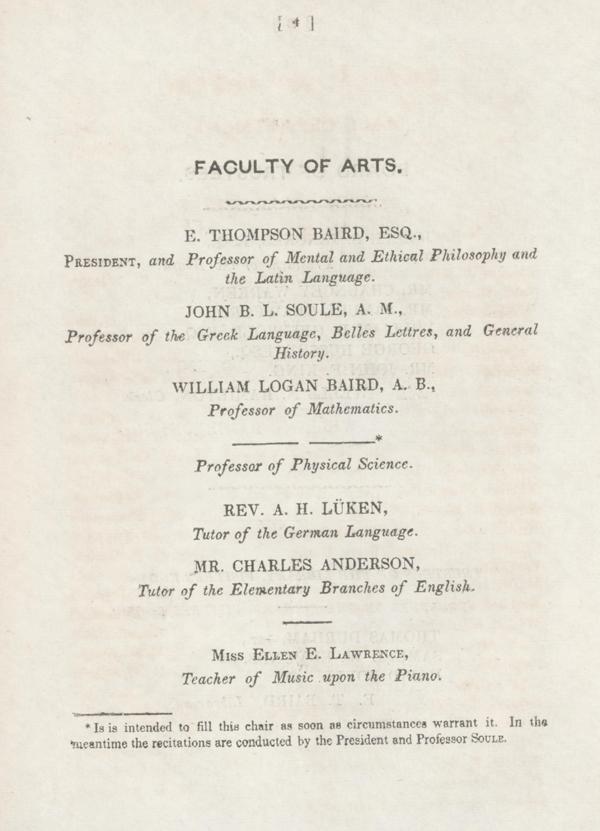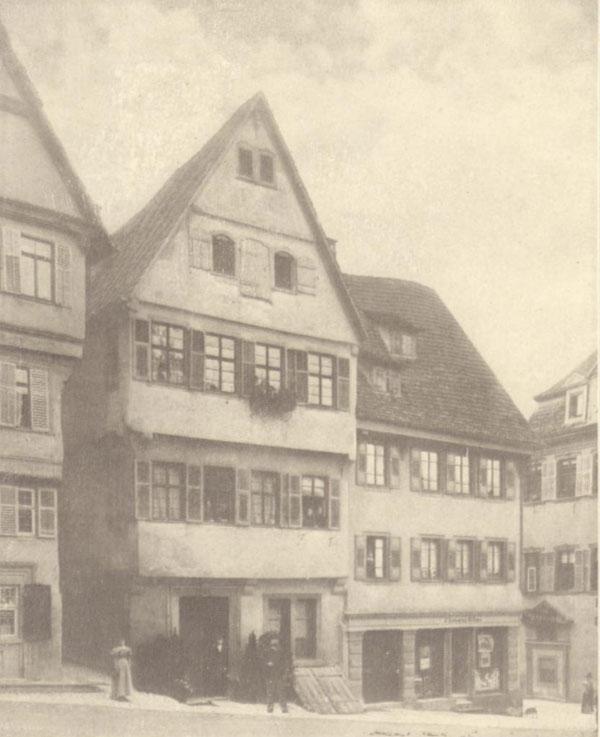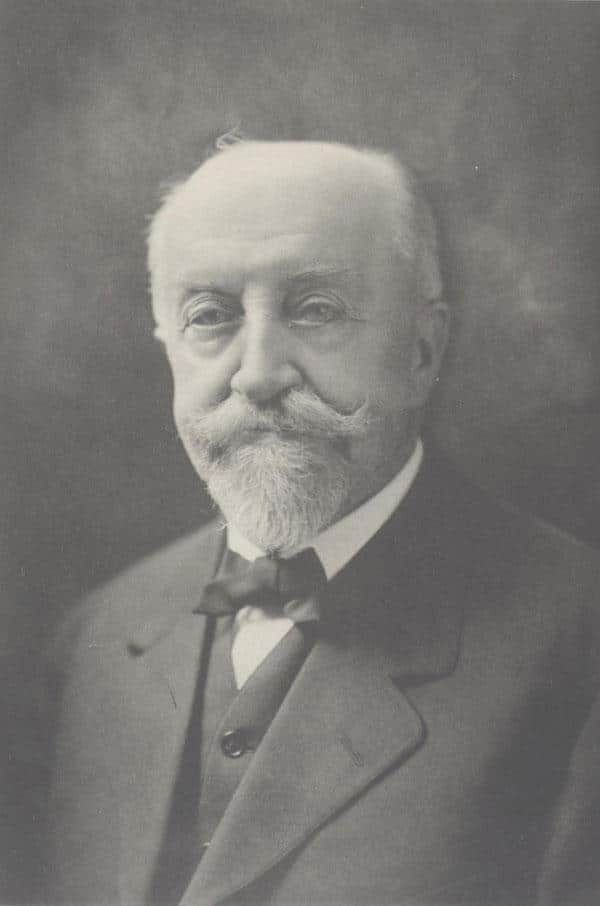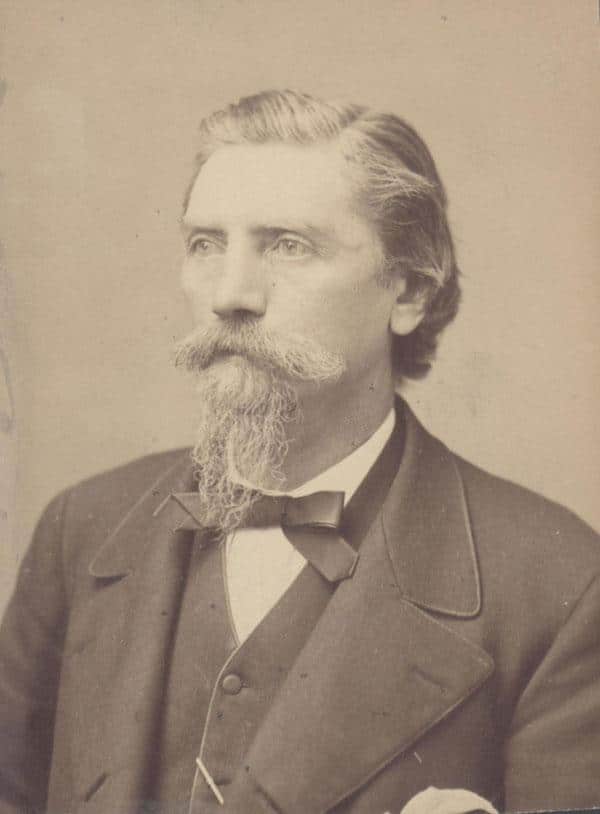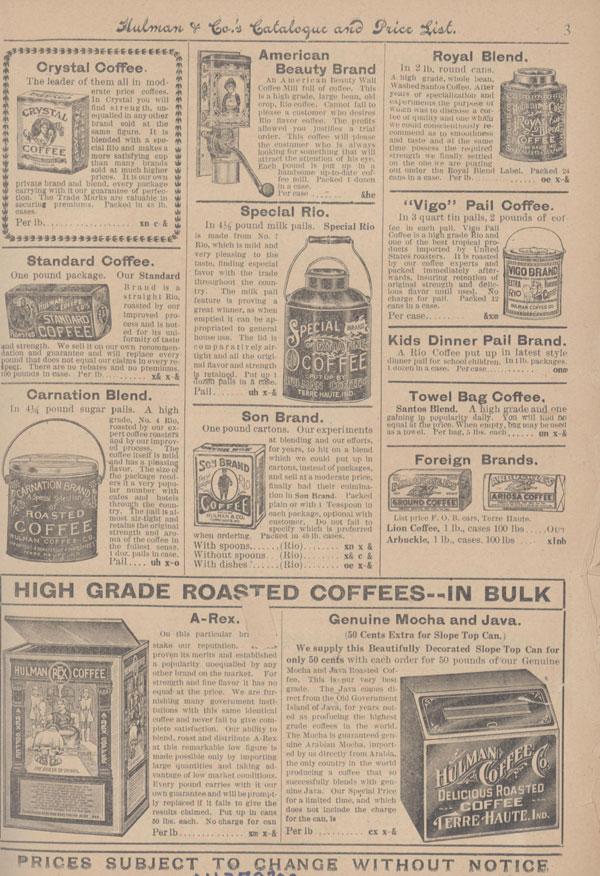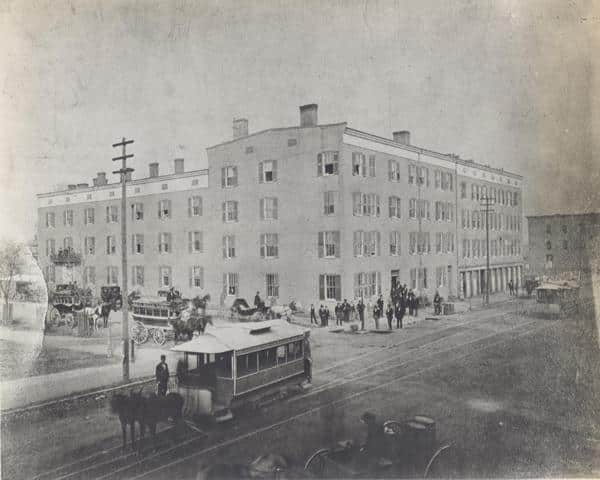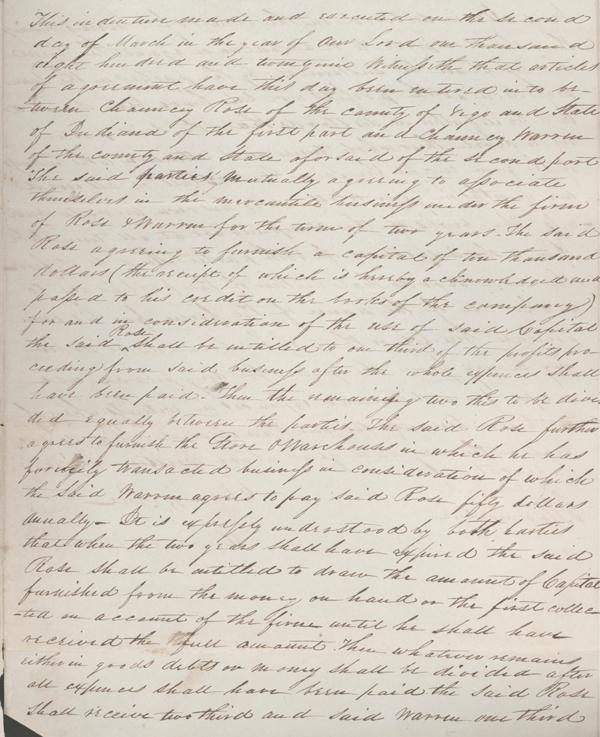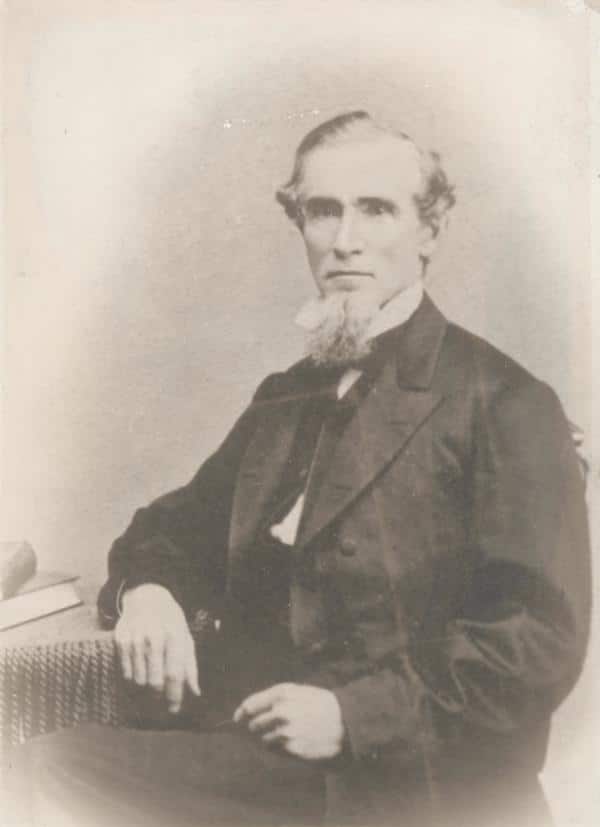Terre Haute Timeline / 1823-1893;
A Hoosier State Chronicles Project
- July 21, 1823
- April 2, 1824
- July 12, 1832
- August 16, 1832
- February 19, 1835
- April 13, 1839
- July 17, 1841
- October 9, 1841
- January 8, 1848
- July 22, 1848
- February 14, 1852
- October 16, 1852
- May 30, 1853
- April 23, 1856
- September 2, 1858
- January 26, 1859
- April 16, 1861
- November 5, 1861
- February 17, 1869
- January 6, 1870
- December 19, 1870
- June 30, 1872
- November 7, 1874
- August 7, 1875
- August 13, 1877
- November 3, 1877
- April 18, 1883
- October 11, 1889
- September 28, 1893
-
Opening of a Public Library
According to the History of the Public Library in Vigo County, provisions for libraries were made in the first state constitution of 1816. At least ten percent of the sale of lots was to be set aside for a library. In 1822, Joseph Jenckes began the purchase of books and John Britton was the librarian. The books, close to eight hundred volumes, were selected from Providence, Rhode Island and the collection was nearly equal to one book per citizen of the village of Terre Haute at the time.
-
Arrival of the Steambot Ploughboy
In 1824, Terre Hauteans proudly welcomed the arrival of the steamboat known as the Ploughboy, the second steamboat to arrive in Terre Haute. The first steamboat, the Florence, arrived at Terre Haute on May 7, 1823 and docked at the foot of Oak Street. As is evident in this newspaper account, the steamboat was an amazing sight to Terre Haute citizens and also helped build the foundation for trade and industry in the city.
-
Dissolution of the Rose & Warren Firm
In the late spring of 1832, the business partnership between Chauncey Rose and Chauncey Warren was dissolved. The goods store which they operated together marked the first important business venture which Chauncey Rose made in Terre Haute. In 1826, Rose was the moving force behind the beginning of the store and Warren worked as his clerk.
-
Town Ordinance Passed About Passengers With Infectious Diseases
Travel along the Wabash was dangerous for many reasons, especially due to the spread of infectious diseases. With limited ability to treat an outbreak of illnesses like smallpox, the recently formed board of health was forced to pass an ordinance in 1832 which would issue a very heavy fine of $500 for any boat captain who knowingly permitted infected persons to travel across the Wabash.
-
Death of Senator William C. Linton
On January 31, 1835, the Terre Haute merchant and statesman William C. Linton passed away. His obituary attested to the great esteem and prominence he held within the Terre Haute community. Linton’s contributions to the city were many. As Vigo County Commissioner, he oversaw the construction of the first courthouse and was president of the first Terre Haute library.
-
Opening of the Prairie House
Advertisements from April 1839 welcomed Terre Haute citizens and travelers to the magnificent and newly opened Prairie House and announces employment opportunities at the hotel. Built by Chauncey Rose in September 1838, the hotel was set on a 320-acre farm that stretched from Walnut to Locust Streets and was the precursor to the Terre Haute House. While the hotel was known as one of the finest in the area, the advertisement also alluded to the sense of convenience and comfort it provided to its tenants.
-
Thomas H. Blake Sells Dry Goods Store to William J. Ball
An important milestone in the commercial life of Terre Haute occurred when Thomas H. Blake sold the entire stock of his dry goods to William J. Ball in July 1841. Thomas Blake’s political career focused on urging funding for the completion of the Wabash & Erie Canal through Terre Haute. William J. Ball, a native of Virginia, had been commissioned to work on the Wabash and Erie Canal as the resident engineer. The management of Thomas Blake’s dry goods store was assisted by Alexander Beard.
-
Recruitment of Students to Saint Mary-of-the-Woods College
A year after the founding of what is now Saint Mary-of-the-Woods College in 1840, new pupils were being recruited. Saint Mother Theodore Guerin and five other Sisters of Providence embarked on a journey from their convent in Ruille-Sur-Loir, France in 1840 to establish an academy for young women in Indiana. Advertisements from October 1841 gave a glimpse into the quality education offered by the academy and the rare opportunity it provided to young women living in this time period.
-
Opening of Vigo Collegiate Institute
The Vigo Collegiate, something like an early experiment in higher education for Terre Haute, was set to open its doors on January 10, 1848. The school was located in the old seminary building, now part of the grounds of Indiana State University. Its first principal was E.T. Baird. Several scholars who took teaching positions here became well known.
-
Mexican-American War
The 4th Indiana Volunteer Infantry had several reliable men willing to join the fight in the Mexican-American War, some of them from Vigo County. An announcement in late July 1848 indicated that these men were waiting to be mustered out. Though held back by finances and infrastructure, several volunteer regiments formed during the governorship of James Whitcomb.
-
Completion of railroad line from Terre Haute to Indianapolis
When the 73 mile stretch to Indianapolis was concluded, a trip across the steel ribbon was taken by Chauncey Rose, mechanic Charles Peddle, and engineer William Baugh on February 14, 1852. By the time trains were steadily moving about the stretch, the Terre Haute Journal was hailing it as a new outlet which labor and goods could be transported that would aid in making Terre Haute “the largest and most flourishing” city in the state. The celebration of the railroad’s completion would not be celebrated until May 1853.
-
First Vigo County Fair held
The first Vigo County Fair was held on Saturday, October 16, 1852. According to the Friday, October 22, 1852 Terre Haute Journal, the fair was not widely attended and “few articles were brought forward for exhibition.” However, interest and attendance was expected to grow for the following year’s fair.
-
Town of Terre Haute Becomes a City
On Monday, May 30, 1853, Terre Haute held its first municipal election to appoint individuals to serve as city officials until the second Tuesday of May 1854. The officials elected consisted of a Mayor, a total of ten Councilmen (two from each Ward), Clerk, Assessor, Civil Engineer, Street Commissioner, Marshal, and City Attorney. William K. Edwards was elected Mayor and a message for the city first appeared on page 2 of the June 10, 1853 issue of the Terre Haute Journal.
-
Chambers Patterson Accepts Nomination for Mayor
Upon accepting the nomination for Mayor, Chambers Patterson declared that as a life-long democrat he was proud to “defeat this beautiful Whig City.” The Wabash Express was founded in 1842 by a prominent Whig citizen, Thomas Dowling. The Wabash Express admonished Patterson to tread lightly lest he “rouse the sleeping lion,” evidently an allusion to the Whig Party.
-
Terre Haute Female College Dedication Ceremony
The Terre Haute Female College was dedicated on Thursday, September 2, 1858. Terre Haute’s R. W. Thompson delivered the address, and music was provided to attendees. The college began accepting pupils on Wednesday, September 8, 1858. The school was founded in hopes of being an alternative for young women who would otherwise travel abroad for their studies.
-
Ulyssean Debating Club Invites George D. Prentice
An advertisement from the Ulyssean Debating Club in the January 28, 1859 edition of the Daily Wabash Express informs readers of the speaking engagement of George D. Prentice, the controversial editor of the Louisville Journal and backer of the Know Nothing Party. Debating clubs helped foster discussion and public education on relevant social and political topics. They were also a forum for hearing different speakers who could alter one’s world view.
-
Citizen’s Meeting at the Outbreak of the Civil War
In mid-April of 1861, the newly formed Confederate forces fired upon Fort Sumter in Charleston, South Carolina in an act of aggression against the Union. Four days later, the citizens of Terre Haute rallied at the Court House in order to show support for the Union and their wishes that “no traitorous hands…break it down.” The meeting was bi-partisan in nature and it was asked that all “paltry differences…about matters of politics” be forgotten.
-
Charles Cruft Engaged as Colonel of the Thirty-First Indiana
The notice of Charles Cruft in November 1861 that his business would be attended to by another man was due to his active engagement as Colonel of the Thirty-First Regiment of Indiana Volunteer Infantry. Cruft’s law partner, John P. Baird, also became active in the Civil War when he was appointed lieutenant colonel of the 85th Indiana Volunteer Regiment.
-
Herz Store Opens
Adolph Herz and David Arnold purchased Benjamin Weisz’s hoop skirt factory on South Fourth Street in February 1869. A German Jewish immigrant to Terre Haute, Herz became one of the best known retailers in downtown Terre Haute and was the founder of the Terre Haute Commercial Club. His store thrived after its move to the northeast corner of Sixth and Wabash. Herz’ business served the community for almost half a century.
-
First group of students begin studies at the Indiana State Normal School
Indiana State Normal School, later Indiana State Teacher’s College and then Indiana State University, received its first students on January 6, 1870. It was founded with the intent that those in attendance could “fit themselves for the teacher’s profession.” There were 135 students enrolled in the school. The timing of the institution’s founding was very fortunate for if it had “been founded sooner its progress would have been painfully slow…” and if later, “it would have missed the chance to pass its initial stage during the years when the free, public school system of the state was coming into being with miraculous rapidity.”
-
Terre Haute Opera House Opens
The Terre Haute Opera House opened to the public on Monday night, December 19, 1870. Nationally renowned comedian John E. Owens appeared in both plays shown on opening night, “Everybody’s Friend” and “Salon Shingle.” Seats in the family circle were available this night only on a first come, first serve basis.
-
Providence Hospital Opens
On June 30, 1872, Providence Hospital was dedicated by the city. The hospital, designed by architect J.H. Vridagh, took two years to build and was located in the northwest part of the city. A “goodly sum” of the $50,000 fee to construct the Catholic hospital was donated by Chauncey Rose. The rest was either donated by others or raised by Catholics.
-
Vigo County Orphan Home Founded
In late October 1874, Chauncey Rose and 13 individuals selected by Mr. Rose founded the Vigo County Orphan Home. Thirty acres of land were obtained for the home itself, which would also be home to “aged females, crippled persons, and…aged males” which were all to be residents of Vigo County. Rose had bequethed $150,000 to the organization at his passing in 1877, so by the time the cornerstone of the building was laid on May 19, 1883, enough interest had accrued to fund the completion of the buildings and grounds.
-
Terre Haute Floods
The week prior to August 7, 1875 was a difficult one for the city of Terre Haute. Heavy rains and flooding cut off railroad transportation and made many roads in the country impassable.
-
Chauncey Rose Dies
On August 13, 1877, Terre Haute philanthropist Chauncey Rose died. Born December 24, 1794 in Wethersfield, Connecticut, he found success in the milling business of Parke County, Indiana before residing permanently in Terre Haute in 1825, where he earned great financial success through real estate. Besides establishing the Prairie House, later the Terre Haute House, on Seventh and Wabash, Rose was best known for his investments in the railroads, seeing them as a way to increase Terre Haute’s role as a center for commerce. He donated a sizable portion of his wealth to organizations in the area, namely the Rose Orphan Home, Rose Dispensary, Rose Ladies’ Aid Society, and Rose Polytechnic School.
-
Curtis Gilbert Dies
Terre Haute lost one of its greatest benefactors, Curtis Gilbert, in 1877. Born in Middletown, Connecticut, on June 8, 1795, Curtis came to Terre Haute in 1814 at the age of 19 following a short stay in New Orleans with his uncle. Before the organization of Vigo County, he was the first postmaster at Fort Harrison. He was well known for his perfectionism both as county clerk and the president of the Terre Haute branch of the State Bank. He died on October 30, 1877 at the home of his daughter, Mrs. W.S. Warner in Manatee, Florida.
-
Flat Boat Trade Still Flourishes
In 1833, the agents Thompson and Condit were seeking steersmen and oarsmen for their flat boats. The flat boat was the major form of transportation for means of trade. Even during the time of the steamboat, the flat boat trade was “too firmly established to be entirely supplanted.” The flat boat was a “veritable ark made to float with the current, and wonderfully adapted to carrying large cargoes of corn, pork, lard and all kinds of country produce down the river to New Orleans.”
-
Axtell Sets Stallion Trotting World Record
On October 11, 1889, Axtell, a three-year-old stallion, set the world record for trotting at the world-famous harness racing track at the fairgrounds, located at Brown and Wabash. Axtell trotted a 2:12 mile while being driven by C. W. Williams of Independence, Iowa. Later that evening, Axtell was sold to a syndicate run by William Putnam Ijams and John Conley for the sum of $105,000, $30,000 more than had ever been paid for any other horse.
-
Expansion of Herman Hulman’s grocery business into Hulman and Company
Herman Hulman, born in Lingen, Germany in 1831, immigrated to the United States in 1854 at the request of his brother, Francis. While living in Terre Haute, he became the proprietor of the Hulman grocery store after his brother’s death. Herman Hulman’s grocery business expanded into a complex of buildings whose construction was completed on September 28, 1893. The city honored this accomplishment in a testimonial dinner with Eugene V. Debs as the guest speaker. Hulman and Company was known for baking products as well as its coffee. Its legacy has been carried on through the Clabber Girl Baking Company.
Digital Collections

Transportation
A study of transportation in early Terre Haute is likewise a study of the people who used the transportation. For example, Terre Hauteans marveled at the spectacle of steamboats but were unsure of its usefulness as H.C. Bradsby recounted in his 1891 history of Vigo County. That could explain why the flat boat trade was so slow to die out. Ten years after the arrival of the first steamboat, agents Thompson and Condit were still seeking men to enter a contract to deliver 4,300 bushels of coal on two flat boats to New Orleans. The trip was grueling and the work back breaking but the work still profitable.
As much profit and pleasure as there could be garnered from transportation, the citizens understood its many perils as well. Ordinances passed in 1832 forbid boats to carry passengers with infectious diseases. The board of health understood the severity of infectious diseases, most of them being doctors themselves who knew they could not afford to handle such an influx of patients. The sickness went on for some time as witnessed firsthand by F.R. Bennett. In a letter dated October 15, 1834, he wrote to his son George Bennett that “at present there has been a great deal of Sickness in our county this season and several deaths.”
Transportation by the mid-1850s reached a major milestone in Terre Haute. One of the major news events for the city occurred when the 73 mile stretch of the railroad from Terre Haute to Indianapolis was concluded. A trip across the steel ribbon was taken by Chauncey Rose, mechanic Charles Peddle, and engineer William Baugh on February 14, 1852. The business relationship between Chauncey Rose and Charles R. Peddle began in March 1851 when Rose offered Peddle a salary of $900 a year as a “Master Mechanic,” and if that was not “as high as the Madison and other companies in the West…” Mr. Rose promised an increase of a thousand dollars more if Peddle requested it. The transcribed letters between Rose and Peddle are housed in the VCPL Community Archives.
W.A. Thompson and D.D. Condit’s June 14, 1833 contract for 5 oarsmen and a captain to ship 4,300 bushels of coal by flat boat to New Orleans.
1834 letter from F.R. Bennett to his son, George Washington Bennett; dated October 15, 1834. From VCPL Archival collection, Early Letters by Terre Hauteans, Accession #861008C.
Transcribed letter from Chauncey Rose to Charles R Peddle, March 1851, from the Chauncey Rose collection, accession #851210A
A sketch of a steamboat from 1872 by Parker Gilmore. Taken from page 20 of Dorothy Clark’s Terre Haute: Wabash River City.
Transcribed letter from Chauncey Rose to Charles R Peddle, March 1851, from the Chauncey Rose collection, accession #851210A
Events

Many exciting advancements were made early on in Terre Haute which were unfortunately not seen to fruition or dramatically interrupted. For example, while a public library had opened in 1822 its need was soon overridden by the reign of township and subscription libraries. It would not be until the 1880s before a public library could be realized again, even though the petitioning had begun as early as 1857.
The United States underwent two major wars between 1846 and 1865. During the Mexican-American War, many men from the Wabash Valley volunteered. Included among them were Josephus Collins of Terre Haute who joined the 4th Indiana Volunteers. In a letter dated March 24, 1848, Collins provided his sister, Hannah, a glimpse of life for a common soldier at his camp in Puebla, Mexico. After the outbreak of the Civil War, it would not be long until Terre Hauteans were called to arms and men like Henry Warren answered that call. After Henry joined the 8th Indiana Artillery, he found himself a year later in the heat of the Civil War. In a letter to his mother from March 16, 1862, he described the conditions of camp, including that the owner of the land was a slave owner who owned “1000 acres…and 40 Negroes.”
Many other things happened in the mid-1800s in Terre Haute: the town being officially named a city, the election of the first mayor and city council, milestones in entertainment, flooding, and the founding of the Vigo County Orphan Home. Through donations left by the late Chauncey Rose amounting to $300,000, the Vigo County Orphan Home was made possible. The Orphan Home was situated on “twenty acres on the Northeast corner of what is now known as South Twenty-Fifth and Wabash Avenue.” Construction started in 1883 and the first orphans were received on September 4, 1884. According to newspaper accounts, the home exceeded all expectations. The Board of Managers changed the name to the Rose Orphan Home in 1930. By 1964, the Rose Home was closed. It had been in existence for 80 years, “serving as an orphanage, later a school and eventually a home for the aged.”
Rose Orphan Home children in sitting room taken from the Rose Orphan Home collection, accession #851202
The first page of a December 9, 1898 letter written to George Farrington from Lyman Alden about the orphans in the home. Taken from the Rose Orphan Home collection, accession #851202
The third page of a December 9, 1898 letter written to George Farrington from Lyman Alden about the orphans in the home. Taken from the Rose Orphan Home collection, accession #851202
First page of a letter from Josephus Collins to his sister, Hannah. Dated March 24, 1848 from Puebla, Mexico to Terre Haute.
People

There were many influential people who were great leaders in Terre Haute before the Civil War who would set the standard for the leaders afterwards. Men like William C. Linton who served in the Indiana Senate in the late 1820s and early 1830s and was involved in the construction efforts of the National Road and the establishment of the State Bank of Indiana. Some political men were reflective of the overall direction of the nation away from the Whig Party. Among this group were men like Chambers Patterson, a Democrat, who was elected mayor in 1856 during the same year James Buchanan defeated Millard Fillmore in the Presidential election. There were also those who proved that local men could serve gallantly in times of war. Among this group were men like Charles Cruft and John P. Baird who halted their law practice to lead troops during the Civil War. Cruft would lead his regiment in many famous Civil War battles, including the Battle of Shiloh. For his gallantry at Shiloh, Cruft was promoted to General, an honor personally conferred “upon him by President Lincoln, on the occasion of his visit to Washington in March, 1865.”
Over time, many of Terre Haute’s greatest leaders passed away but left a wonderful legacy to follow. The city lost two of its earliest and most prominent benefactors in 1877. Chauncey Rose died in August and Curtis Gilbert died in October. Chauncey Rose was born on December 24, 1794 in Wethersfield, Connecticut. He was successful in real estate and eventually established the Prairie House, later the Terre Haute House as a local tavern and hotel. Rose was also a major investor in railroads and amassed a fortune through his investments. His namesake lived on through the Rose Orphan Home, Rose Dispensary, Rose Ladies’ Aid Society, and Rose Polytechnic School. Curtis Gilbert was born in Middletown, Connecticut, on June 8, 1795 and came to Terre Haute in 1814. He served as postmaster at Fort Harrison which preceded Terre Haute. He also served as county clerk and president of the Terre Haute branch of the State Bank.
Front side of a land deed showing Curtis Gilbert had purchased land from Henry Alvin for the price of $11.19, dated November 12, 1827. From the Early Land Records collection, accession #861016D
Back side of a land deed showing Curtis Gilbert had purchased land from Henry Alvin for the price of $11.19, dated November 12, 1827. From the Early Land Records collection, accession #861016D
Chauncey Rose’s obituary was published on page 5 of the August 18, 1877 issue of the Saturday Evening Mail. It filled 1 1/2 of the 6 columns on the page.
Portrait of Chambers Y. Patterson (1824-1881), elected twice as mayor but better known for his service as circuit court judge. Taken from the VCPL Archives.
Education

Before the founding of Indiana State Normal School, opportunities in higher education were still not limited. Those opportunities just lay in a state in which they would later be able to flourish. Several adventurous and courageous individuals believed Terre Haute to be the perfect place for scholarship to thrive. In 1840, Saint Mother Theodore Guerin who had overcome many adversities in her native France still had the courage to come to America and found a school for young women in the woods of Sugar Creek Township of Vigo County, a feat that ultimately proved successful. In 1848, E.T. Baird took a chance on the yet undeveloped Vigo Collegiate Institute and attracted the talents of J.B.L. Soule, Professor of Belles-lettres, and J.G. Stevenson, a mathematics professor who later became Librarian of Congress. The use of the Institute’s grounds paved the way for what would become Terre Haute High School. Lastly the Ulyssean Debating Club, graced in its meetings by the presence of many famed lecturers, was used by James B. Harris as a means to advocate for an institute of higher learning.
These beginning years of Terre Haute saw increased interest in higher education. The Terre Haute Female College, later known as Covert College and Western Female College, was dedicated in September 1858. Founded by the Rev. John Covert, the school, which consisted of three buildings on 8 1/2 acres, attracted 232 students in its first year. The school later became the center of Saint Anthony’s Hospital. Indiana State Normal School, later Indiana State Teacher’s College and then Indiana State University, received its first students on January 6, 1870 with the intention of preparing its students for the teaching profession.
Page from the 1862 Terre Haute Female College catalog. Taken from the College and Universities collection, accession #860910
June 1861 Program of the Fourth Annual Terre Haute Female College’s Concordia Literary Society exhibition. Taken from the College and Universities collection, accession #860910
Page from the book A History of Indiana State Teachers College: (Indiana State Normal School, 1870-1929), by William O’Lynch
Listing of original nine Normal School faculty taken from the College and Universities collection, accession #860910
Meeting minutes of the Ulyssean Debating Society from September 13, 1857. From accession # SM DC 45A.
Business & Industry

Business and industry in Terre Haute has always been driven by a few highly influential people who used capital and leadership experience to build the local economy. A prime example was Chauncey Rose who in 1829 furnished an additional $10,000 of capital into his goods store and entered a partnership with Chauncey Warren. When the partnership was dissolved, Rose had sold his stock to Warren who continued to make the business a success until his failing health forced him to sell the business to his brothers. Rose, despite warnings of almost certain failure, took a risk in 1839 with the founding of the Prairie House. Seemingly prophetically, the hotel’s location would later become the “Crossroads of America.” Other risk-takers included Thomas H. Blake and William J. Ball. Blake’s efforts and political influence brought the Wabash and Eerie Canal to Terre Haute but he built his reputation as a reputable merchant first. William J. Ball earned his fame as the chief engineer of the Evansville & Crawfordsville Railroad in 1850, and later with the Terre Haute, Alton & St. Louis Railroad.
The latter half of the 19th century brought immigrants from Germany to Terre Haute who were very successful in business. These men included Adolph Herz, born in Wurtemburg, Germany in 1843. Herz came to Terre Haute in 1867 to work for the tailor Joseph Erlanger. He entered into the retail clothing business when he and David Arnold purchased Benjamin Weisz’ hoop skirt factory on South Fourth Street in February 1869. His business served the community for almost half a century and his namesake to the store lived on even with changes in management and ownership. Herman Hulman was born in 1831 in Lingen, Germany and came to Terre Haute at the request of his brother, Francis. This eventually led to his proprietorship of the Hulman family grocery which was the predecessor to Hulman and Company, later the Clabber Girl Baking Company.
Terre Haute House, formerly the Prairie House, as it appeared in 1869. Photograph courtesy of the Martin Family Photos.
Articles of incorporation for the Rose and Warren firm. Taken from folder 5 of the Henry Warren Civil War letters, Accession #: 20160114, in the VCPL Archives.

This project is made possible by a grant from the U. S. Institute of Museum & Library Services, administered by the Indiana State Library. To search historic Indiana newspapers online, visit the Hoosier State Chronicles.


